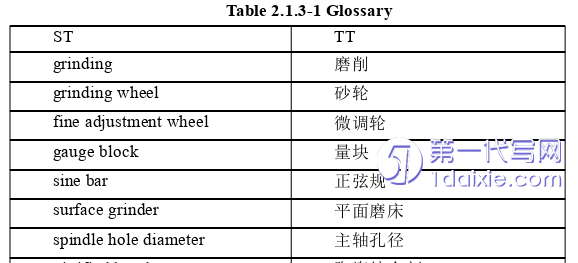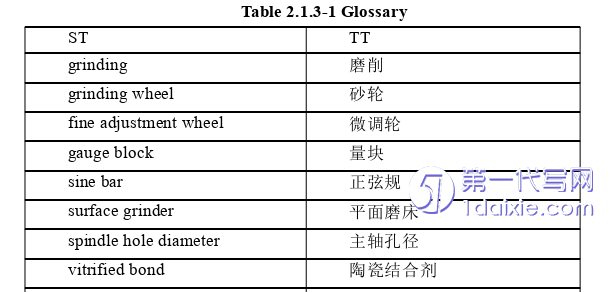本文是一篇英语毕业论文,笔者通过分析该文本发现:该材料在词汇层面有很多专业词汇和意义丰富的普通词汇,在句法层面多被动句、长难句和名词化结构,在语篇层面存在逻辑不清的现象。
1.Task Description
1.1 Background of the Project
After decades of efforts,China has made remarkable achievements in the mechanicalmanufacturing industry and made it become an essential industry in China.There is aparticular gap compared with the world’s industrial powers.Facing the increasing internationalcompetitive pressure and industrial upgrading dilemma,China should accelerate thetransformation and upgrading of the industry and improve its strength.Parts are the pivotallink in the process of mechanical manufacturing.Improving the quality and performance ofparts in the machining process could raise mechanical manufacturing enterprises’efficiencyand economic benefits.
With the support of local industrial enterprises,the master of translation and interpretingin the translator’s school is featured by English for Science and Technology.According to thegraduate training program for the master of translation and interpreting,there was a six-monthinternship in XXX Machinery Co.,Ltd.from July 2021 to January 2022,during whichconsiderable professional knowledge related to machinery was acquired.The role involvestranslating product introduction and production process with a total translation volume of150,000 words.A keen interest was brought about in mechanical manufacturing during theinternship.Workshop Machining is a mechanical manufacturing text which includes sevenchapters:introduction,degrees of freedom,turning,milling,surface grinding,cylindrical grinding,and drilling.It was first published in 2022.The important and representative fifthchapter,surface grinding,is selected as the material of the translation practice report.

1.2 Significance of the Project
The CPC Central Committee has set the goal of building a modern economic system andrealizing a new type of industrialization by 2035.China is committed to building a globalindustrial power,and the translation of English for science and technology is of greatimportance to acquiring advanced technologies from developed countries.But the overall levelof translation of English for science and technology is still limited,which sometimes makesChinese readers unable to understand information expressed in the original text.
Ai(2021)suggests that eco-translatology emphasizes the concept of beingtranslator-centered,systematically interprets the inner relationship between the ecologicalenvironment and translators,and comprehensively raises the translator’s translation ability.Asa new translation mechanism,eco-translatology provides a new perspective for the translationof English for science and technology.Guided by eco-translatology,translators mightguarantee the accurate transmission of the original text and make multi-dimensionaladaptation selections to realize the unique functional attributes and content specificationrequirements of the original text on the macro and micro levels.Therefore,the analysis of thetranslation of mechanical manufacturing text from the standpoint of eco-translatology cancontribute to the research of eco-translatology in the field of scientific and technologicaltranslation.
From the perspective of the practice,Workshop Machining is a mechanicalmanufacturing text with powerful practicality,which can supplement the weaknesses ofmachining in China.It may provide some guidance for manufacturing enterprises that pursuehigh-precision parts and college students majoring in mechanical design and manufacturing tobasic machining technology.A detailed analysis of the original text is made based on thetranslation practice and adopted different translation methods to obtain the optimal translation,which provides references for the future translation of English for science and technology.
2.Translation Process
2.1 Before Translation
Without a comprehensive analysis and careful preparation,it is impossible to do ahigh-quality translation.Therefore,it is necessary for a qualified translator to fully understandthe background of the original text and the purpose of the target text to select appropriatetranslation methods.Numerous preparations are made before translation,including making atranslation plan,selecting appropriate translation tools,and building a term list to proceed withtranslation smoothly.
2.1.1 Translation Plan
Workshop Machining is a comprehensive textbook that explains the fundamentalprinciples of manually operating machinery to form shapes in various materials.The fifthchapter,surface grinding,is selected as the final translation practice text through comparisonand selection.It includes about 13,000 words and 21 pictures.After evaluating the content ofthe original text,the difficulty of translation,and the deadline of translation practice,thetranslator decides to complete it in three time periods.The translation plan is as follows:before starting the translation,15 days is used to collect information about mechanicalprocessing and establish a glossary by online and offline reoriginals.The first draft is finishedwithin 15 days,with a daily translation volume of about 1000 words.The translator adjusts theamount of translation according to the difficulty of daily translation tasks.At the same time,the features and difficulties of the text are summarized during the translation.Finally,thetranslation’s proofreading and polishing would be completed through the efforts of thetranslator,students in the same team and friends majoring in mechanical design andmanufacturing within 30 days.It is a challenging task to complete the whole translationpractice project within 2 months.
2.2 While Translation
The translation material was writed by David Harrison.There has been no translation inChinese through check the translation in the paper check system.After many times to verify,no one has translated it so far.The mechanical manufacturing text belongs to texts of Englishfor science and technology with the characteristics of objectivity,clarity,conciseness,andaccuracy.In the translation process,the following features of the text are summarized throughreading and translating the text to provide a basis for the subsequent case analysis.
Li(2015)suggested that scientific and technological texts mainly emphasize theelaboration of objective facts and rarely involve the translator’s own emotions and feelings.From the perspective of words,the words in this text contain a large number of technical terms,synthetic technical terms,and common words.Technical terms are only used in themechanical manufacturing industry and have the distinctive feature of a single meaning.Synthetic technical terms are often derived from common words,so the boundaries betweenthe two are blurred.This text mainly provides guidance for junior technicians in machiningoperations and uses considerable common words.Common words have different meanings ingeneral and mechanical contexts and have the characteristics of various usages.The translationof synthetic technical terms and common words should be emphasized to ensure the accuracyand authenticity of the translation.
3.Eco-translatology..........................................12
3.1 Introduction........................................12
3.1.1 Background of Eco-translatology.....................12
3.1.2 Three Core Concepts of Eco-translatology..............................13
4.Case Study..................................................16
4.1 Adaptive Selection in the Linguistic Dimension.......................16
4.1.1 Conversion.........................................16
4.1.2 Free Translation.....................18
5.Conclusion...........................................29
5.1 Major Findings.................................29
5.2 Limitations and Suggestions..................................30
4.Case Study
4.1 Adaptive Selection in the Linguistic Dimension

Chinese and English belong to two different language families,so there are greatdifferences in language forms.There are also many differences between English and Chinesein grammar,sentence structure,and phonetics.The essence of language interference is that thelanguage structure of the original text affects the translator and makes him unable to expressthe meaning of the original text with the natural translation(Xu,Yuan,1998:41).From theperspective of the target language,translators should respect the objectivity and accuracy ofthe original text and give full play to their subjective initiative to make an adaptive selection.An adaptive selection in the linguistic dimension means that the translator chooses the optimallanguage form of the source language in the target language environment to achieve thetransformation.
4.1.1 Conversion
The state of expression tends to be static in English,while it tends to be dynamic inChinese according to the saying of Shao and Shao(2010).There are many nouns,adjectives,and prepositions used in English sentences compared with Chinese sentences.The Chineselanguage emphasizes the dynamic description with a tendency to use verbs.From theperspective of eco-translatology,translation is regarded as translators’adaptation and selectionto keep the life of texts and keep the ecological balance between the original text and thetranslated text(Hu,Li,2022:98-102).It is necessary for the translator to adopt the conversionof part of speech to achieve the optimal selective selection from the linguistic dimension.
5.Conclusion
5.1 Major Findings
As China is committed to becoming a world manufacturing power,the translation ofmachinery manufacturing text is very important to obtain advanced science and technologyfrom foreign industrial powers.Under the guidance of eco-translatology,the report explorestranslation methods to the mechanical manufacturing text,Workshop Machining:SurfaceGrinding.Lacking professional mechanical knowledge,the translator has done numerouspreparatory work in the early stage to master the language characteristics of the original text.Analyzing the characteristics of this translation material is the key prerequisite for translation.The text has the universal characteristics of objectivity,clarity,conciseness,and accuracy.Inaddition,the translation material has many technical terms and common words with richmeanings at the lexical level.There are many sentences with passive voices,long and complexsentences,redundant information,and nominalized structures at the syntactic level,as well asillogical situations at the textual level.
Lack of obvious cultural factors in the text,the adaptive selection is made in thelinguistic and the communicative dimensions to produce the translation with the highestintegration fitness.From the perspective of the linguistic dimension,for common words withrich meanings and some special static expressions in the original text,the translatorrespectively adopts free translation and conversion of part of speech to make the languageform of the original text adapt to the target language environment.There are fewer passivevoices in the Chinese language.It is necessary for the translator to convert passive voices toactive voices according to the specific situation to ensure the accuracy and preciseness of thetranslation.Additionally,for long and complex sentences,the translator separates longsentences into short sentences to achieve the balance of the ecological environment oftranslation.In the communicative dimension,when the abstract nouns and pronouns in the textare too abstract and unclear,the translator appropriately adds some words to convey clear andprecise information to the target readers.And the translator deletes the redundant informationin the text to improve the reading efficiency of the readers.Finally,the translator adjusts thelogical relation of sentences in order to solve the logical confusion in the original text.
reference(omitted)
